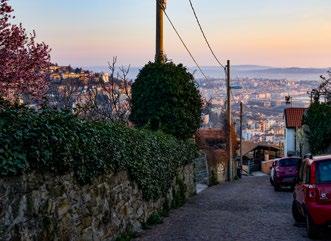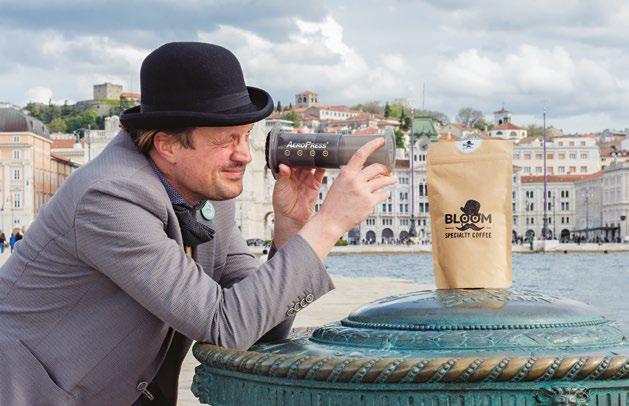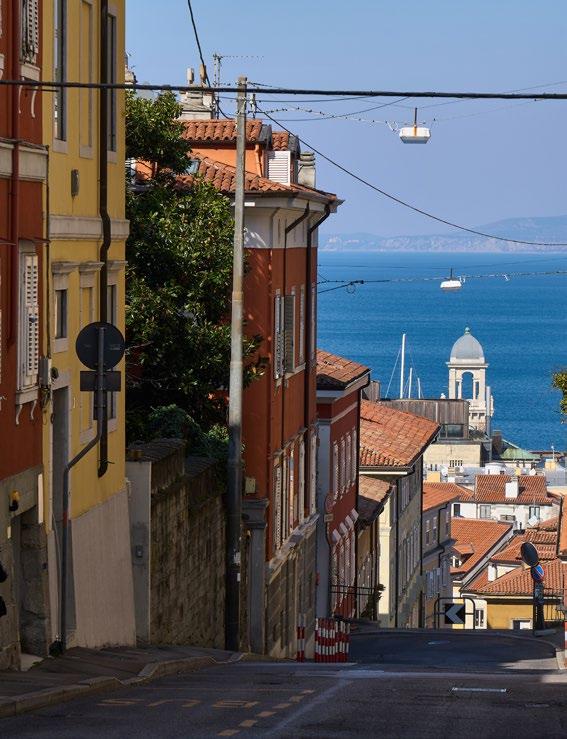
6 minute read
SQUARCI GLIMPSES
Trieste invita a vedute, visioni e prospettive originali
Trieste boasts original views, visions and perspectives
Advertisement
Uno squarcio non può essere misurato, né confinato all’interno di uno schema preciso. Può essere sostantivo o verbo, così come è in grado di disegnare uno strappo nello spazio visivo, spalancare alla vista le possibilità degli uomini e delle donne; non c’è limite alle sue mutazioni, o ai suoi utilizzi e no, non è termine negativo. Rimbomba nella lingua parlata come un’improvvisa rivoluzione e distrugge la staticità dell’equilibrio. È provocazione ed allo stesso tempo inaspettata apertura. Trieste abbonda di squarci, siano essi storici o geologici, o ad essi si vogliano dare altri significati. Non si vedono spesso, a dire il vero, o almeno così non vengono percepiti da chi ci vive o ci passeggia. Eppure, la potenza di ciò che ribalta le convinzioni è dappertutto, in questa città. L’ultimo squarcio fisico manifestatosi di recente è la restituzione al viaggiatore della monumentale entrata del porto vecchio [1]
Per aprire lo spazio alla curiosità si è dovuto buttare giù un ex teatro dismesso (una fu stazione per corriere, ormai semi abbandonata). Sì, gli squarci sono anche materia per fisici, considerando le azioni e le reazioni che essi stessi producono. Camminando e perdendosi, in questa città il viaggiatore scoprirà gli angoli dimenticati più suggestivi e respirerà le novità, senza per forza affidarsi all’intermediazione delle mappe geografiche o dei “dieci posti da non perdere”.
Fanno rumore, gli squarci, regalano l’emozione di ciò che non conosciamo. La salita alla scala Ciamician [2] e lo sguardo all’orizzonte, a volo d’uccello sopra il campanile di santa Maria del guato (così i triestini chiamano il Salone degli incanti [3], un tempo rumorosa pescheria cittadina), restituisce la gioia di un sospiro. Esclamazioni dialettali in via d’estinzione sono pilastri che tengono in piedi – meglio in vita – le identità locali: tartàifel (indemoniato), indrioman (di seguito), come pure matavilz (valerianella), s’cenza (scheggia), s’cinca (biglia) o s’ciopeta (piccolo panino con taglio centrale) –in generale tutte le parole che presuppongono una ‘sc’ sincopata ed interrotta da un apostrofo– producono movimento e guizzi linguistici che qui si possono ancora ascoltare.
Trieste è stato tempio di squarci nel suo passato. Da qui viaggiano i soldi che gli Asburgo investono nel taglio dell’istmo di Suez –in fondo una vera e propria rivoluzione. Qui, nei trent’anni che trascorrono tra la prima e la seconda guerra mondiale, la Storia mette in fila ferite sanguinolente che a fatica si stanno rimarginando, grazie alla comprensione riscoperta negli ultimi vent’anni. Una trincea –il Carso ne è pieno– è uno squarcio, come pure lo è una separazione nelle relazioni. Gli squarci nella terra non sono esclusivi di un martirio giuliano-dalmata (e quindi anche nel racconto delle foibe [4]), bensì trovano realizzazione anche nella speleologia, nelle grotte e in tutto ciò che sta sotto la superficie terrestre. La terra si apre continuamente, a Trieste e dintorni.
Si aprono scorci all’orizzonte anche quando i violenti temporali smettono di percuotere l’aria. Qui, dalla piazza principale della città [5], si apre la vista sulle Alpi carniche, d’inverno innevate. Quegli squarci sono anche e soprattutto il magnete che attrae i triestini a viaggiare e a proiettare le proprie esistenze chissà dove, lontano da qui. Lo squarcio che l’elica di Ressel [6] mette in moto rivoluzionando l’ingegneria mondiale nasce qui, in riva all’Adriatico, nel XIX secolo. Il canal grande taglia in due il borgo Teresiano [7], dove un tempo si “coltivava” il sale e la voglia di grandeur triestina. Squarci come segni del passato, eppure utili a far sì che nel presente trovi spazio l’orizzonte.

Ma a Trieste gli squarci si trasformano spesso in scorci. Per trovarli basta uscire dal centro e salire verso le prime alture che circondano la città. Potrebbe essere monte Valerio [8] (sopra la sede centrale dell’università), come pure scala Santa [9], nel rione di Roiano. Qui, sempre nel mese di settembre, si svolge da anni la rampigada (arrampicata) santa, vale a dire una gara ciclistica amatoriale che si conclude all’obelisco di Opicina [10] , dopo pendenze che toccano il 20 per cento. È qui, nella dimensione sportiva, che lo squarcio muta e diventa scorcio, vista e tramonto.
Ma gli squarci –come gli scorci, non fa differenza– servono soprattutto quando portano il viaggiatore da altre parti, alla stregua di complici consapevoli nell’iniziazione di un processo. Con l’abbattimento della sala Tripcovich chi giunge da fuori fotograferà il monumentale ingresso del Porto vecchio, fino a ieri rimasto nascosto. Il passo successivo sarà entrarci.
Agash has no straight lines or right angles, and can hardly be made to fit an exact diagram. The term “gash” can be both a noun and a verb, just as one can gash, or make a tear, into visual space, thus creating a gash, or an opening, for women and men to be able to see their possibilities. There is no limit to its mutations or the purposes it may serve, in its most positive sense. The uttered word echoes like a sudden revolution, shattering the static frame of balance; it provokes and it surprises. Triestes gashes are numerous – gashes of history, gashes in the ground, gashes for every possible meaning.
Gashes are not easy to spot, or rather are not easily spotted by those who live within or walk through them. Yet, their powerful force overturning certainties and convictions dwells in every corner of Trieste. The latest physical gash in the city’s urban fabric is the restored main entrance of Porto Vecchio[1]: opening it to the public meant tearing down the abandoned building of an ancient courier station, later turned into a theatre, which had long since fallen into disuse. After all, gashes involve the very physics of matter, considering the actions and reactions they trigger. Wandering, even drifting through the city streets, visitors may discover beautiful, yet forgotten corners, and breathe in the air of ongoing change – no map to rely on, or topten list to go through.
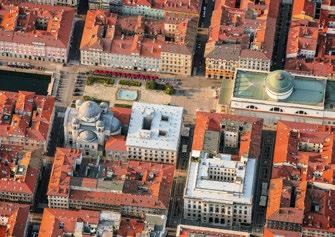
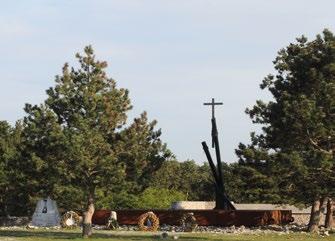
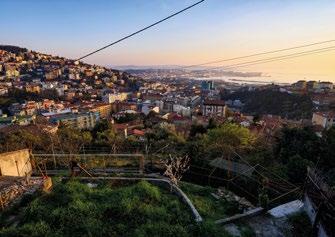

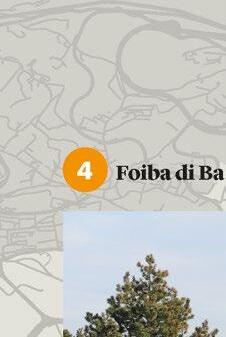
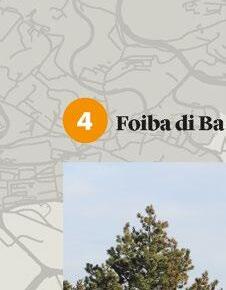
Gashes are loud as the sound of the unknown. Climbing the steps of Scala Ciamician [2] , visitors cannot help but sigh with joy, as their gaze roams free over the belltower of Santa Maria del Guato (lit. Holy Mary of the Gaze, as Triestini call today’s Salone degli Incanti [3], once a lively fish market). Exclamations in local vernacular, idioms of a dying language, are the pillars supporting this territory, almost keeping its identity alive: tartàifel (wild, possessed), indrioman (without interruption, one following the other), matavilz (corn salad), s’cenza (splinter), s’cinca (marble), s’ciopeta (small bread roll with a longitudinal incision) – and in general every word with a syncopated “sc” sound in their first syllable, interrupted by an apostrophe – create a sort of movement, made of language jolts and darts that are still very much alive in this area.
Trieste has a long history of gashes: it is the departure point of the Hapsburgs’ investment into the gash built within the Isthmus of Suez, later known as the Suez
Canal – a revolution in its own right. The gashes of history, especially those inflicted during the thirty years separating World War I and II, were bleeding wounds that have only recently started to heal, thanks to a spirit of understanding that has inspired the past two decades. A trench [4] is a gash, as witnessed by the scarred surface of the Karst Plateau. And a gash in the earth often opens a painful tear in relations between local peoples, as witnessed by the Istrian–Dalmatian exodus and the foibe massacres. However, there also other gashes running through these rocks, less horrific and more natural: caves, potholes, tunnels…the earth opens quite frequently around here.
When thunderstorms fall silent and the air is respited from the violent strikes of the wind, the sky seems to open and cast a new gaze upon the horizon. Piazza Unità [5] offers an unobstructed view of the Carnic Alps and, in winter, their snow-covered tops. These gashes are the catalyst pushing Triestini to journey, as they project their lives elsewhere, far from here. This northern-most corner of the Adriatic Sea is where Ressel’s propeller [6] was designed and started in the 19th century, its pull a trailblazing force of engineering innovation which would later sweep over the globe. Trieste’s canal grande cuts through Borgo Teresiano [7], once the city’s saltworks, yielding both salt and aspirations of grandeur. Gashes as traces of the past, but also openings that offer a horizon to the present.
The gashes of Trieste often turn into glimpses and full-fledged views. One only need head towards the upland, leaving the city centre behind. Monte Valerio [8] (overlooking the main University campus) and Scala Santa [9] (in Rione Roiano) are two of Triestini’s favourite destinations. The latter is where the rampigada santa (lit. holy climb) takes place every year in September: a cycling race for amateurs, with slopes that may reach an incline gradient of 20%, and finish line at Opicina’s obelisk [10]. The sport dimension has the power to turn a gash into a glimpse, a view, and a sunset.
Gashes, as well as glimpses, are first and foremost an invitation to travellers, like an intriguing voice that initiates a process. The gash left by the demolition of Sala Tripcovich turned into the majestic view of the main entrance of Porto Vecchio, otherwise hidden. Now, you only need to take a step inside.
